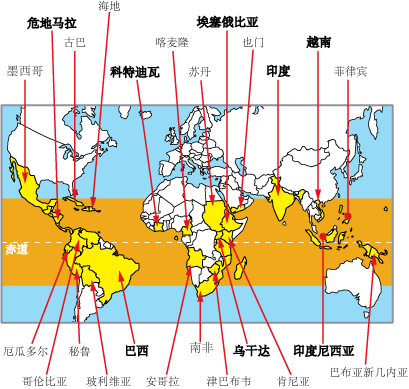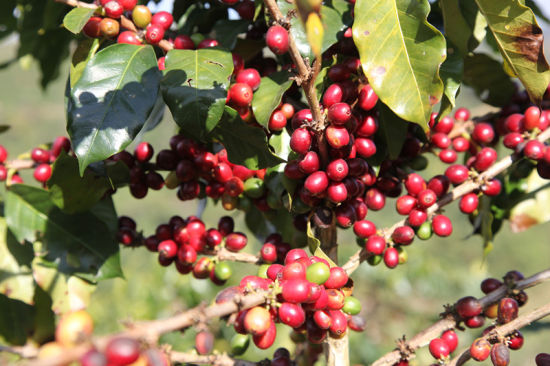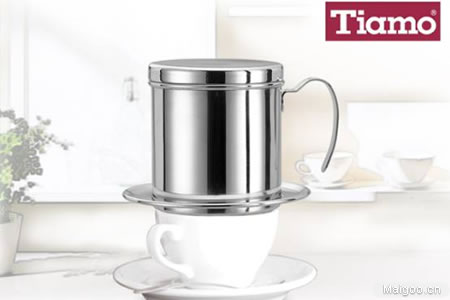Vietnamese coffee is characterized by Japanese investment in Vietnamese coffee and French flavor.
Vietnam
Today's production power, tomorrow's production giant.
Perhaps under the influence of French colonial rule, coffee grown in Vietnam has a French flavor. Arabica coffee was first brought to Vietnam by French missionaries. More than 400,000 coffee trees were introduced to Vietnam from 1865 to 1876 and were planted near Tonkin Bay, mostly Java or bourbon varieties.
At present, Vietnam's coffee production is growing. Among Vietnam's new export products, tea ranks first and coffee ranks second. The main varieties produced are Robbite coffee beans, which exported 66000 bags in 1980 and soared to more than 200,000 tons in 1994. 96% of Robert's coffee comes from small farms, but some state-owned farms also grow coffee trees.
The yield of coffee in Vietnam is as high as 950 kilograms per hectare, and many newly planted coffee trees are invested by the Japanese.
Two years ago, I read a survey report that Vietnam has overtaken Colombia in coffee bean production, ranking second in the world after Brazil. But the trees planted are Robusta trees, and there is still a big gap between the quality of coffee beans and countries like Colombia and Brazil.
Vietnam's geographical location is very favorable for coffee cultivation. Southern Vietnam has a hot and humid tropical climate, which is suitable for growing ROBUSTA coffee, while the north is suitable for growing ARABICA coffee. Coffee production in Vietnam has the following characteristics
Characteristics: (1) because there is no effective way to deal with fallen leaves, medium-grain coffee was selected as the main variety in the early 1980s. (2) based on the planting technology, the coffee planting method was determined, that is, under the hot and humid climate in southern Vietnam, high density planting, large amount of irrigation, excessive fertilization and no shading trees were used to obtain the maximum yield and give full play to the production capacity of medium-grain coffee. The per unit yield of many coffee plantations in Daklak, GiaLai, Kontum and DongNai areas of Vietnam reached 340t / ha. The yield of some plantations is even as high as 89.9 tons per hectare. (3) processing technology: mainly making full use of the solar energy drying method in the dry season in the plateau of central Vietnam to process coffee.
Coffee cultivation in Vietnam covers an area of about 500000 hectares, of which 10% are owned by state-owned enterprises and farms, and 85% by farmers and landowners. The scale of the manor is small, usually 2-5 hectares, and the large manor is about 30-50 hectares, but the number is small. Vietnamese coffee ranks second in all agricultural products exported from Vietnam, second only to rice. Every year, about 300000 farmers are engaged in coffee cultivation, with a labor force of 600000, and the labor force can reach 700000 to 800000 in the three-month harvest period. as a result, the coffee industry has absorbed 1.83% of the country's total labor force and 2.93% of the total agricultural labor force.
Vietnam Coffee Corporation (VINACAFE) is a 100% state-owned enterprise with 73 companies and farms under its jurisdiction. VINACAFE exports 20-25% of Vietnam's coffee production each year.
According to the business statistics of Vietnam Coffee Association, in 2000-2001 (from October 2000 to September 2001), a total of 874676 tons of coffee were exported from 149 units in Vietnam, of which the three largest export companies were OLAM (wholly foreign-owned enterprise, 21326 tons), DAKMAN (joint venture, 18076 tons) and VINAFIMEX (local enterprises, 13719 tons).
The Vietnam Coffee quality Standards Committee was led by the Vietnam Coffee Association to draft the Vietnam National Coffee Standard, which was reported to the Ministry of Science, Technology and Environment (now the Ministry of Science and Technology) for examination and approval.

Important Notice :
前街咖啡 FrontStreet Coffee has moved to new addredd:
FrontStreet Coffee Address: 315,Donghua East Road,GuangZhou
Tel:020 38364473
- Prev

Asian boutique coffee Java Sumatra Sulawesi Flores Lindong Mantenin G1
Indonesia is a refreshing coffee that you can drink at any time. Coffee is produced throughout Indonesia (Indonesia), and Java occupies an extremely important position in coffee history. In the mid-17th century, coffee trees were introduced to Indonesia by the Dutch (some official sources believe that earlier). The first batch of coffee from Java was sold to Amsterdam in 1712.
- Next

Simple how to use Vietnamese coffee pot how to use Vietnamese coffee pot
Vietnamese coffee pot is probably what we know most about Vietnam, a neighboring country. Vietnam, once a French colony, began to grow coffee around 1860. The unique history has formed the unique flavor and connotation of Vietnamese coffee. Vietnamese coffee pot plays an important role in this, and it is also the most important coffee utensils for Vietnamese coffee.
Related
- Does Rose Summer choose Blue, Green or Red? Detailed explanation of Rose Summer Coffee plots and Classification in Panamanian Jade Manor
- What is the difference between the origin, producing area, processing plant, cooperative and manor of coffee beans?
- How fine does the espresso powder fit? how to grind the espresso?
- Sca coffee roasting degree color card coffee roasting degree 8 roasting color values what do you mean?
- The practice of lattes: how to make lattes at home
- Introduction to Indonesian Fine Coffee beans-- Java Coffee producing area of Indonesian Arabica Coffee
- How much will the flavor of light and medium roasted rose summer be expressed? What baking level is rose summer suitable for?
- Introduction to the characteristics of washing, sun-drying or wet-planing coffee commonly used in Mantenin, Indonesia
- Price characteristics of Arabica Coffee Bean Starbucks introduction to Manning Coffee Bean Taste producing area Variety Manor
- What is the authentic Yega flavor? What are the flavor characteristics of the really excellent Yejasuffi coffee beans?

